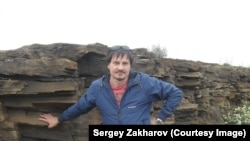Donetsk artist Serhiy Zakharov once preferred the bright rays of the July sun to the faint gaze of the midnight moon -- at least when it came time to set up his street installations mocking pro-Russian separatists.
"It wasn't realistic to do it at night, because there weren't people, just armed separatists driving around," Zakharov told RFE/RL's Russian Service from Kyiv, where he's moved after a month and a half as a captive of the self-proclaimed Donetsk People's Republic. "I would quickly scope out a location, set up my work, have the photographer take a picture, then we'd call it a day and get out of there."
Without the time to stencil his images into Donetsk's many facades, he would construct painted plywood cutouts in advance.
But when the artworks -- which included former insurgent commander Igor Strelkov holding a gun to his head above the Nike catchphrase, "Just Do It" -- went viral, the artist's situation became more precarious.
Hunted
Tracked down and apprehended outside his studio in early August, Zakharov says that during two stints in captivity separatists fractured his left and right ribs and threatened him with execution three times. And where once he used offbeat satire to reflect all that was bizarre among Donetsk rebels, his new work, in the form of an upcoming comic book, echoes his own grim experience at the hands of his captors.
In pencil sketches provided to RFE/RL, Zakharov shows a world that blends monotonous moments among other detainees with daily torture sessions and the ever present fear of death.
After his initial capture, Zakharov was brought to a basement cell where he says a woman wearing a balaclava and speaking with "a clear Russian accent" was tasked with beating and torturing the detainees. Here, he says, the main goal was "take away a sense of self-worth."
From there it got worse.
Zakharov says his captors handcuffed him to another prisoner, stuffed them both in the trunk of a car, and brought them to the military commissariat in the Donetsk district of Proletarskiy.
There, he says, they were locked in an iron box with little room to even wiggle and were kept under the "scorching sun" for two days.
Mock Executions
Afterwards, according to Zakharov's account, the two were kept handcuffed to each other for another 10 days.
He also says he was subjected to at least three mock executions.
"I have always wanted to know what goes through a man's head when he's facing death," Zakharov says a female separatist, playing the role of executioner, told him during one such encounter.
Zakharov, likely referring to "The Idiot," says he shot back, "Read Dostoyevsky. He describes it."
Rights groups have accused both pro-Russian separatists and Ukrainian forces of "abductions, torture, and killings" in the conflict in eastern Ukraine, which started in April and has continued despite a cease-fire signed by Kyiv, Moscow, and separatist representatives in early September. RFE/RL has documented several cases of prisoner abuse at the hands of pro-Russian separatists, including public beatings.
In mid-August, Zakharov, who does not know what became of the man he was handcuffed to, was given 5 hryvnia ($0.39) and released.
But the next day, after hospital X-rays confirmed broken ribs, he says his girlfriend -- apparently not suspecting that he could be taken in once more -- drove him to the home base of his captors at the old State Security Service (SBU) building so he could collect his documents. Instead, he was detained again and spent another month in captivity before being released for the second time in late September and fleeing to Kyiv.
When Zakharov began his guerrilla street art campaign three months ago, the separatist movement felt to him like an unpleasant, but transient, phenomenon. He says that although many supported the separatists, others felt at ease laughing at and photographing his work.
But no one dares criticize the de-facto authorities now.
"By the time I left, the situation had changed," he says. "It seems that Donetsk has been abandoned, tossed away. People have returned and at the household level things have gotten better. There are some [artillery] volleys here and some shooting there -- but for residents this is already something they've become accustomed to."
















